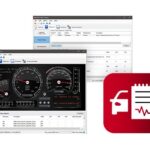For car enthusiasts and everyday drivers alike, understanding what’s happening under the hood is becoming increasingly important. Modern vehicles are complex machines filled with sensors and computers, constantly monitoring performance and health. To tap into this wealth of data, tools like the ELM327 interface and OBD2 protocols are essential. But what exactly are they, and how do they work together to give you insights into your car’s operation?
At its core, the ELM327 interface is a microchip that acts as a translator, bridging the gap between your car’s onboard diagnostic system (OBD2) and your smartphone or computer. The OBD2 standard, mandated in most vehicles since 1996, dictates a universal communication protocol for accessing vehicle data related to emissions and engine performance. This standardization is crucial because it means that a single tool, like an ELM327 OBD2 adapter, can work across a wide range of car makes and models.
The beauty of the ELM327 interface lies in its ability to support all OBD2 protocols. These protocols are essentially different languages that car manufacturers use for communication. The most common OBD2 protocols include:
- ISO 15765-4 CAN (Controller Area Network): The dominant protocol in modern vehicles.
- ISO 14230-4 KWP2000 (Keyword Protocol 2000): Used in many European and Asian vehicles.
- ISO 9141-2: An older protocol found in some Chrysler, European, and Asian vehicles.
- SAE J1850 PWM (Pulse Width Modulation) & SAE J1850 VPW (Variable Pulse Width): Protocols used in older Ford and GM vehicles respectively.
Because the ELM327 interface supports all these OBD2 protocols, it ensures broad compatibility, making it a versatile tool for car diagnostics. When paired with a user-friendly application like Car Scanner ELM OBD2, you can unlock a wealth of information about your vehicle directly on your smartphone or tablet via a Bluetooth or Wi-Fi connection.
With Car Scanner and an ELM327 OBD2 adapter, you gain access to features previously only available to professional mechanics with expensive scan tools. You can:
- Read Real-Time Data: Create custom dashboards displaying gauges and charts showing engine temperature, RPM, speed, and dozens of other parameters.
- Diagnose and Reset Fault Codes (DTCs): Identify the meaning behind those pesky check engine lights and even clear them after addressing the issue. Car Scanner includes a comprehensive database of DTC descriptions to help you understand the problem.
- Monitor Vehicle Performance: Measure acceleration, track fuel consumption, and assess sensor data to understand your car’s health and efficiency.
- Access Advanced Features: For experienced users, Car Scanner allows access to extended PIDs (Parameter IDs) for deeper insights and Mode 06 for ECU self-monitoring test results, aiding in more complex diagnostics. For VAG group vehicles, even coding functions are available.
Choosing the right ELM327 OBD2 adapter is important. While budget-friendly options exist, it’s recommended to opt for reputable brands to ensure reliable connection and data accuracy. Be wary of very cheap clones, especially those marked “v2.1,” as they can be buggy and cause connection issues. Brands like Kiwi 3, Viecar, V-Gate, Carista, LELink, and Veepeak are generally recommended for their quality and performance.
In conclusion, the combination of the ELM327 interface’s universal OBD2 protocol support and a powerful app like Car Scanner empowers car owners to take control of their vehicle’s diagnostics and monitoring. Whether you’re a seasoned mechanic or just curious about your car’s inner workings, this technology provides valuable insights and can potentially save you money on maintenance and repairs.
